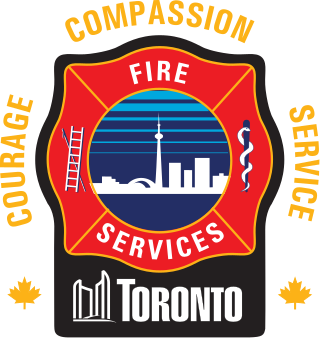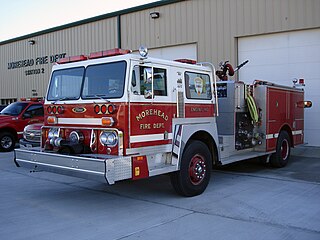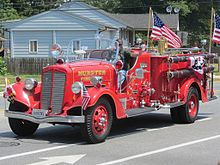
A fire engine is a road vehicle that functions as a firefighting apparatus. The primary purposes of a fire engine include transporting firefighters and water to an incident as well as carrying equipment for firefighting operations. Some fire engines have specialized functions, such as wildfire suppression and aircraft rescue and firefighting, and may also carry equipment for technical rescue.

Mack Trucks, Inc., is an American truck manufacturing company and a former manufacturer of buses and trolley buses. Founded in 1900 as the Mack Brothers Company, it manufactured its first truck in 1905 and adopted its present name in 1922. Mack Trucks is a subsidiary of AB Volvo, which purchased Mack along with its then parent company Renault Véhicules Industriels in 2000.

The term 1932 Ford may refer to three models of automobile produced by Ford Motors between 1932 and 1934: the Model B, the Model 18, and the Model 40. These succeeded the Model A. The Model B had an updated four-cylinder engine and was available from 1932 to 1934. The V8 was available in the Model 18 in 1932, and in the Model 40 in 1933 & 1934. The 18 was the first Ford fitted with the flathead V-8. The company also replaced the Model AA truck with the Model BB, available with either the four- or eight-cylinder engine.

Crosley was a small, independent American manufacturer of subcompact cars, bordering on microcars. At first called the Crosley Corporation and later Crosley Motors Incorporated, the Cincinnati, Ohio, firm was active from 1939 to 1952, interrupted by World War II production. Their station wagons were the most popular model, but also offered were sedans, pickups, convertibles, a sports car, and even a tiny jeep-like vehicle. For export, the cars were badged Crosmobile.
There are many types of car body styles. They vary depending on intended use, market position, location, and the era they were made in.

Toronto Fire Services (TFS) provides fire protection, technical rescue services, hazardous materials response, and first responder emergency medical assistance in Toronto, Ontario, Canada. Toronto Fire Services is currently the largest municipal fire department in Canada.

Opel Blitz was the name given to various light and middle-weight trucks built by the German Opel automobile manufacturer between 1930 and 1975. The original logo for this truck, two stripes arranged loosely like a lightning symbol in the form of a horizontally stretched letter "Z", still appears in the current Opel logo. The Blitz name was then applied to the British-made Bedford CF when it replaced the Blitz in certain markets.

American LaFrance (ALF) was an American vehicle manufacturer which focused primarily on the production of fire engines, ladder trucks, and emergency apparatus such as ambulance and rescue vehicles. Originally located in Elmira, New York, the final iteration of the company was located in Summerville, South Carolina. It also operated a Canadian plant in Toronto, Ontario, where it sold apparatus under the name LaFrance-Foamite, until 1971.

The Keeton was a brass era automobile built in Detroit, Michigan from 1912 to 1914 by the Keeton Motor Car Company.

Firefighting in the United States dates back to the earliest European colonies in the Americas. Early firefighters were simply community members who would respond to neighborhood fires with buckets. The first dedicated volunteer fire brigade was established in 1736 in Philadelphia. These volunteer companies were often paid by insurance companies in return for protecting their clients.

Willys was a brand name used by Willys–Overland Motors, an American automobile company, founded by John North Willys. It was best known for its design and production of World War II era and later military jeeps (MBs), as well as civilian versions, and branding the 'jeep' military slang-word into the '(Universal) Jeep' marque.

Gramm-Bernstein Company, also known as Gramm Motor Car Co. and Gramm Truck Co., was an automobile company in Lima, Ohio in the early 20th century. The company was an early manufacturer of power wagons and advertised 1, 2, 3, and 5 ton models with "any style of body desired". Vehicles were sold through the Willys-Overland Motors. Gramm received a $1,225,000 order "for trucks said to be for commercial purposes in Great Britain" in 1916. A manufacturing plant was designed by Lima architectural firm McLaughlin & Hulsken.
C. D. Beck & Company, of Sidney, Ohio, was an American intercity motorcoach and transit bus manufacturing company that was founded in 1931.
The New Haven Fire Department (NHFD) provides fire protection and emergency medical services to the city of New Haven, Connecticut. The New Haven Fire Department currently serves a population of over 130,000 people living in 19 square miles of land and is one of the largest fire departments in the state.

HME, Incorporated is a custom fire engine manufacturer in Michigan.
The Yonkers Fire Department (YFD) provides fire protection and emergency medical services to the city of Yonkers, New York, United States.

A firefighting apparatus describes any vehicle that has been customized for use during firefighting operations. These vehicles are highly customized depending on their needs and the duty they will be performing. These duties can include firefighting and emergency medical services.

An electric fire engine is a fire engine that is powered by an electric motor—essentially, an electric vehicle designed and used for firefighting. Electric fire engines were first proposed in the 19th century to replace the steam pumpers used for firefighting. The electric motor was claimed to be simpler, cleaner, and faster in operation, would save money, and require less maintenance than the steam fire engine. Though production of most electric-powered fire engines ended in the early 20th century when they were superseded by diesel-powered fire engines, they have seen a revival in the 21st century, with fire engine manufacturers such as Rosenbauer and Pierce Manufacturing designing their own electric fire engines.

The Penrith Museum of Fire is an Australian firefighting museum that contains heritage-listed former operating and stored for preservation fire service vehicles located in Penrith, Sydney, Australia. The provenance of the firefighting vehicles date from 1841 to 1998. The fleet of vehicles was added to the New South Wales State Heritage Register on 25 February 2013.

The Bedford HC is a small commercial vehicle that was made by Bedford, beginning in 1938. The vehicle shared its running gear with the H-series Vauxhall 10-4 saloon. Production of civilian vehicles ceased during World War II with the HC van re-entering production for a little while following hostilities. The HC was later joined by the heavier duty Bedford JC, which was itself replaced by the higher-roofed Bedford PC after the war. With the arrival of the much more modern Bedford CA the by now outmoded PC was finally retired.


















